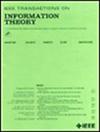Limiting Moments of Autocorrelation Demerit Factors of Binary Sequences
IF 2.2
3区 计算机科学
Q3 COMPUTER SCIENCE, INFORMATION SYSTEMS
引用次数: 0
Abstract
Various problems in engineering and natural science demand binary sequences that do not resemble translates of themselves, that is, the sequences must have small aperiodic autocorrelation at every nonzero shift. If f is a sequence, then the demerit factor of f is the sum of the squared magnitudes of the autocorrelations at all nonzero shifts for the sequence obtained by normalizing f to unit Euclidean norm. The demerit factor is the reciprocal of Golay’s merit factor, and low demerit factor indicates low self-similarity of a sequence under translation. We endow the二值序列自相关缺陷因子的极限矩
工程和自然科学中的许多问题都要求二值序列本身不类似于平移,即序列在每一个非零位移处必须具有小的非周期自相关。如果f是一个序列,那么f的缺点因子是通过将f归一化为单位欧几里德范数得到的序列的所有非零位移的自相关的平方和。缺点因子是Golay优点因子的倒数,缺点因子越低表明序列在平移作用下的自相似性越低。我们赋予长度为$\ell $的$2^{\ell } $二值序列统一的概率测度,并考虑其缺点因子的分布。早期的工作使用组合技术来找到作为$\ell $函数的分布的均值、方差、偏度和峰度的精确公式。这些结果表明,对于$\ell \geq 4$,该分布的第p个中心矩对于每个$p \geq 2$都是严格正的。本文表明,对于每一个p,第p个中心矩等于$\ell ^{-2 p}$乘以具有有理系数的$\ell $的拟多项式函数。它还表明,在$\ell $趋于无穷大的极限下,第p个标准矩与标准正态分布的矩相同。
本文章由计算机程序翻译,如有差异,请以英文原文为准。
求助全文
约1分钟内获得全文
求助全文
来源期刊

IEEE Transactions on Information Theory
工程技术-工程:电子与电气
CiteScore
5.70
自引率
20.00%
发文量
514
审稿时长
12 months
期刊介绍:
The IEEE Transactions on Information Theory is a journal that publishes theoretical and experimental papers concerned with the transmission, processing, and utilization of information. The boundaries of acceptable subject matter are intentionally not sharply delimited. Rather, it is hoped that as the focus of research activity changes, a flexible policy will permit this Transactions to follow suit. Current appropriate topics are best reflected by recent Tables of Contents; they are summarized in the titles of editorial areas that appear on the inside front cover.
 求助内容:
求助内容: 应助结果提醒方式:
应助结果提醒方式:


